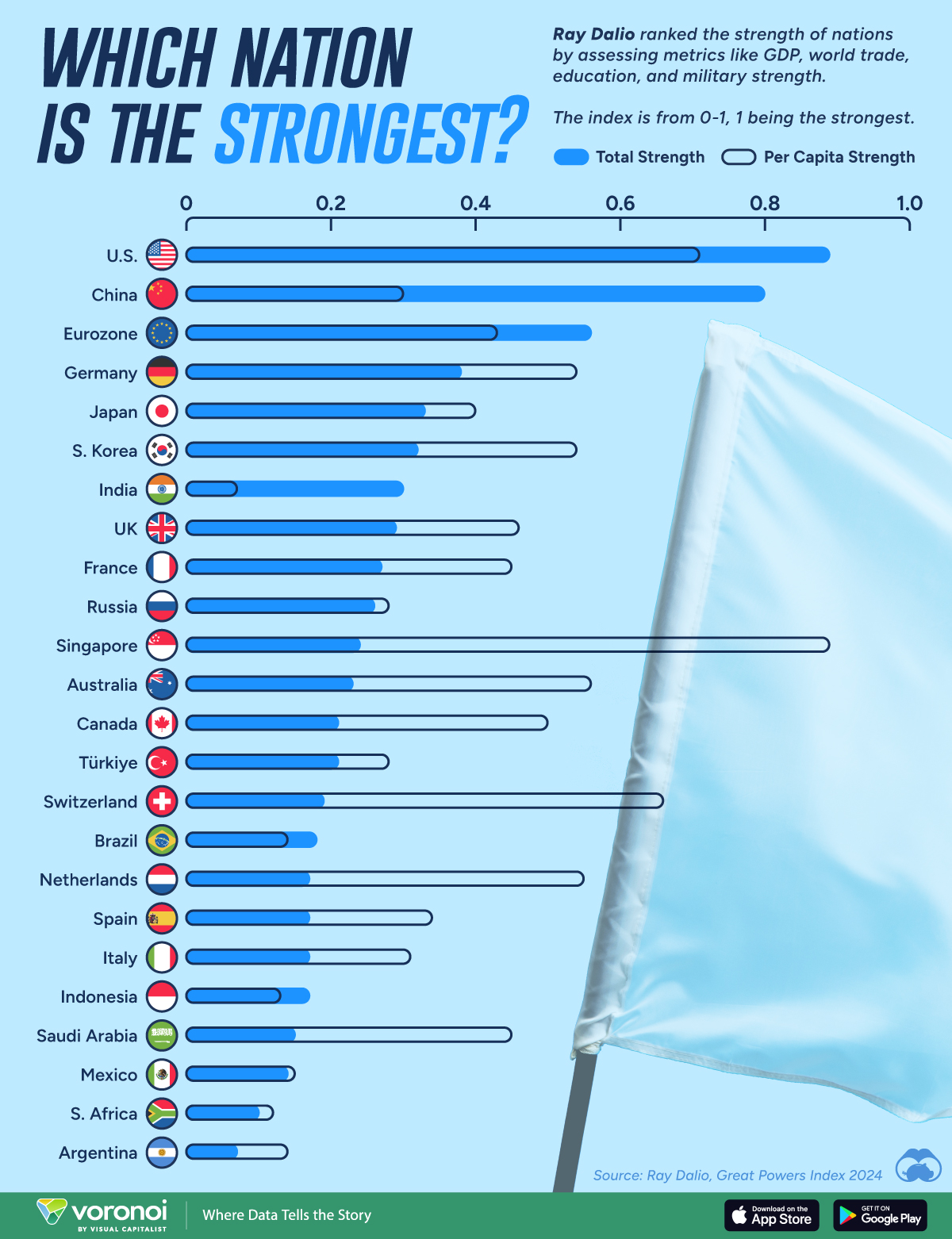
What is Showing
This graphic ranks the strength of major economies in 2024, based on analysis from Ray Dalio’s Great Powers Index 2024.
Methodology
Dalio assessed each nation’s strength based on a wide range of metrics including the following:
- Education
- Innovation and Technology
- Cost Competitiveness
- Economic Output
- Military Strength
Key Takeaways
- The U.S. maintains its status as the world’s leading superpower, thanks to its dominance in global financial markets, reserve currency status, and technological innovation
- As the world’s largest exporter, China follows next, driven by its strength in trade and economic output
- India, ranking in 7th, is projected to see the fastest real GDP growth over the next decade across countries analyzed
Dataset
| Country | Total Strength | Per Capita Strength |
|---|---|---|
| U.S. | 0.89 | 0.71 |
| China | 0.8 | 0.3 |
| Eurozone | 0.56 | 0.43 |
| Germany | 0.38 | 0.54 |
| Japan | 0.33 | 0.4 |
| South Korea | 0.32 | 0.54 |
| India | 0.3 | 0.07 |
| UK | 0.29 | 0.46 |
| France | 0.27 | 0.45 |
| Russia | 0.26 | 0.28 |
| Singapore | 0.24 | 0.89 |
| Australia | 0.23 | 0.56 |
| Canada | 0.21 | 0.5 |
| Turkey | 0.21 | 0.28 |
| Switzerland | 0.19 | 0.66 |
| Brazil | 0.18 | 0.14 |
| Netherlands | 0.17 | 0.55 |
| Spain | 0.17 | 0.34 |
| Italy | 0.17 | 0.31 |
| Indonesia | 0.17 | 0.13 |
| Saudi Arabia | 0.15 | 0.45 |
| Mexico | 0.14 | 0.15 |
| South Africa | 0.1 | 0.12 |
| Argentina | 0.07 | 0.14 |
The U.S. remains the world’s foremost superpower, bolstered by its dominance in global financial markets and technological innovation.
The U.S. dollar’s influence is widespread. Today, it involved in 85-90% of foreign currency exchange trades, accounting for 59% of foreign exchange reserves, and comprising around half of cross-border bank loans. Moreover, U.S. stock market capitalization represents 61% of the global total.
As the world’s largest exporter, China follows next, driven by its strength in trade and economic output. As one example, trade with Latin America has surged from $12 billion in 2000 to $315 billion in 2020. Strengthening its global position further is China’s growing military might. Today, the country has the world’s largest naval fleet and a highly modernized defense sector.
India, ranking in 7th, is projected to see the fastest real GDP growth over the next decade across major economies. Powering its growth is vast infrastructure spending and a young demographic. Yet on a per capita basis, India falls last, likely due to lower average per capita incomes and an uneven distribution of wealth.
By contrast, Singapore has the highest score on a per capita basis, illustrating that the nation’s power is the most evenly distributed across its population. The island country is a global hub for finance and trade, while foreign direct investment is a key driver of economic growth.

